You may have encountered the People Also Search For section on a Google SERP before and found the keywords listed within it.
But what are these People Also Search For keywords? Where, exactly, do you find them on the SERPs? And how do you utilize them for better organic search traffic?
We’ll cover all of that and more in this blog post.
Jump to Section:
- What are People Also Search For keywords?
- The relationship between People Also Search For keywords and search intent.
- How to find People Also Search For keywords.
- How to utilize People Also Search For keywords for organic traffic growth.
- How to rank for People Also Search For keywords.
What are People Also Search For Keywords?
People Also Search For keywords are specific keywords that appear within the People Also Search For box on a Google SERP.
Google’s algorithm has chosen these keywords closely related to the original search query that has been typed in. They are generated based on what other users have searched after browsing the SERP on the original query.
Let’s look at an example.
If I search Google for “content marketing,” I will see the following SERP:
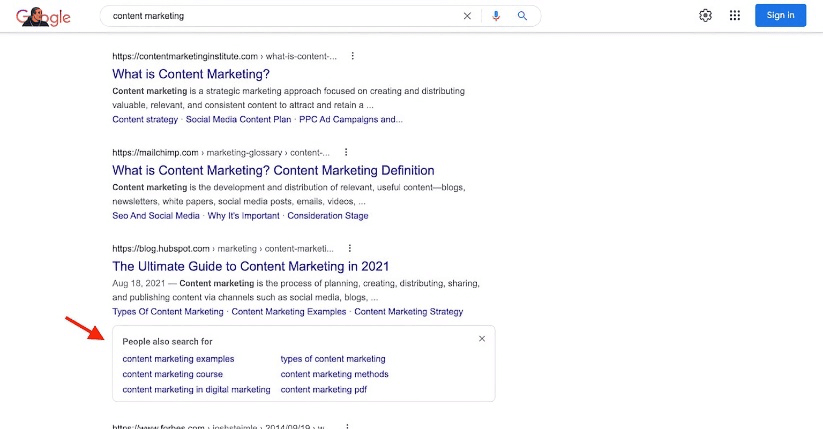
The People Also Search For box appears underneath one of the search listings.
The Relationship Between People Also Search For Keywords and Search Intent
The relationship between keywords in People Also Search For boxes and specific search intent for different queries is big, and you need to understand it to grow your organic search traffic.
People Also Search For keywords show you what type of refinements are made to queries, giving you a hint as to what additional information people typically look for after their initial search. This provides clues about their underlying intent.
Search intent generally falls into one of four categories:
- Informational
- Navigational
- Transactional
- Commercial
Check out our search intent guide to learn more about these intents and their meaning.
People Also Search For keywords often reveal the intent behind a particular query by showing related searches.
For example, if the original search was “how to plant a garden,” People Also Search For keywords might include examples such as “best plants for beginners” or “garden planting tips,” which indicates there is a desire for more detailed information.
If the search is for a specific brand or website, People Also Search For keywords might show variations of that brand or related brands, which suggests that users might be exploring options or looking for a specific site.
For a search like “buy running shoes,” People Also Search For keywords might include “best deals on running shoes” or “running shoes discount,” which highlights a clear intent to make a purchase.
By understanding the People Also Search For keywords that are showing up for your target keywords, you, as a marketer, can better tailor your content to meet your audience’s search intent. This will greatly impact user satisfaction and increase the likelihood of better engagement and conversion rates.
Incorporating People Also Search For keywords into your SEO strategy, especially during the keyword research stage, helps you align your content more closely with user intent. Over time, this can improve keyword rankings as search engines aim to deliver the most relevant results that match user intent.
How to Find People Also Search For Keywords
There are a couple of different methods that you can utilize to find keywords showing in the People Also Search For boxes for your keywords. You can search manually on Google for them or use the Keywords Everywhere Browser Extension.
The next section will cover how to find People Also Search For keywords using each method.
Google Searches
Finding People Also Search For keywords using Google is a relatively simple process.
To start, head to Google and type in a search. In this example, we’re using the search term “acai berries,” but you can search for any term you like.
Click on the link in the SERP to take you to the web page, then click back.
If Google has People Also Search For data stored for this particular website, you will be able to see the People Also Search For box show up with a list of people and also search for keywords listed under it, as you can see here:
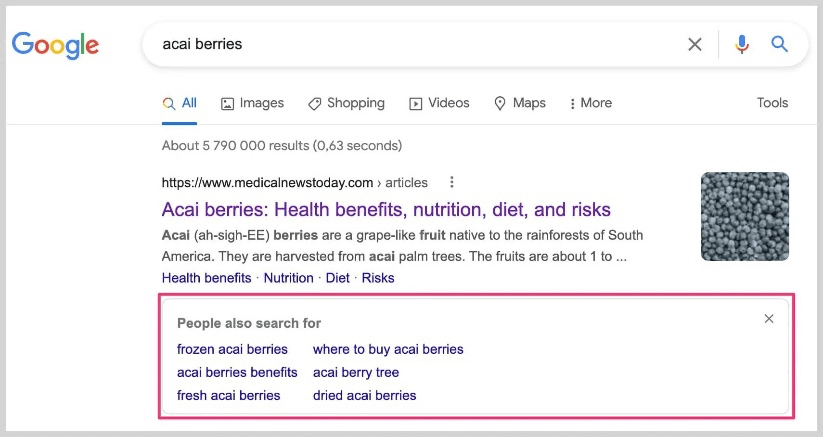
It’s worth noting that this might not be the best tactic in real-world terms, as Google does not store People Also Search For data for every website on the SERPs. Utilizing an external tool or an extension on your web browser may be better.
Keywords Everywhere Browser Extension
Keywords Everywhere works similarly to searching for People Also Search For keywords manually; only the extension takes all the work and does this for you.
Start by installing the extension. Keywords Everywhere has extensions for Google Chrome, Mozilla Firefox, and Microsoft Edge.
Once you have the extension installed, you must purchase a subscription. Their pricing starts at $27, billed annually, and goes up to $960, billed annually. You need a subscription to use Keywords Everywhere.
Now that you have the extension installed and purchased a subscription, simply return to the normal process and enter a keyword on Google. The only difference is that, within the SERP, Keywords Everywhere will automatically pull ‘Related Keywords’ for you, and it will show this on the right-hand side of the SERP.
These related keywords are pulled from People Also Search For boxes for the particular query you search for.
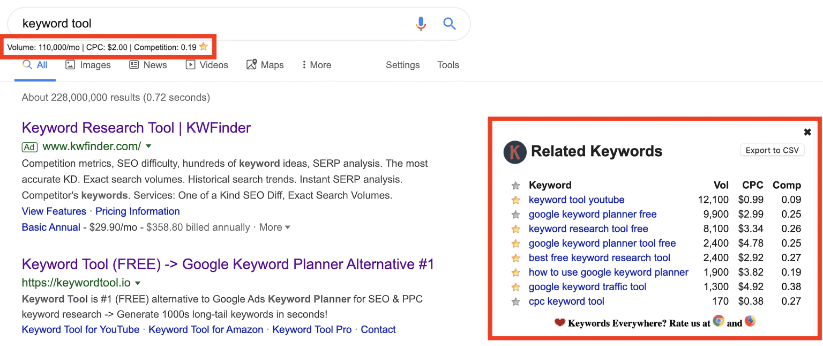
How to Utilize People Also Search For Keywords for Organic Traffic Growth
The keywords in People Also Search For boxes on Google are useful for several reasons, from finding content ideas to researching FAQs to incorporate into existing content to improve on-page SEO.
We’ve already discussed the relationship between these keywords and query search intent, but in this next section, we will discuss how these keywords can be used to grow organic traffic.
Find Content Ideas
People Also Search For keywords are incredibly useful for finding additional content ideas for your website.
Let’s say you have written a piece of content, and the target keyword for this content is “SEO tips.” You can utilize the People Also Search For keywords to find gaps in your existing content, questions the user asks when searching for your seed keyword, and anything else you might have missed in the original piece.
Given that People Also Search For keywords are generated based on what a searcher types next after leaving a particular website, this is your opportunity to write content that keeps them on your page.
Once you have written your content piece, you may find People Also Search For keywords listed as:
- Ecommerce SEO Tips
- Local SEO Tips
- YouTube SEO Tips
You can then use the list above to expand your original content and keep as many users engaged on your page as possible. This will lead to better rankings, as we know that Google uses click data (to a certain extent) within its ranking algorithm.
Quick Tip: You can do this with a content refresh, too. Take an existing piece of content and find the People Also Search For keywords for your page’s target query. Then, expand and refresh your content to cover these keywords and set up an SEO test that monitors your engagement rate via GA4. You can do this in SEOTesting. You’ll then see precisely how doing this impacts your engagement rate, page clicks, impressions, and average position.
FAQ Research
People Also Search For keywords are invaluable for adding FAQs to your website’s new and existing content pieces.
People Also Search For keywords often include questions that the user searches after researching a particular query. To ensure these types of users stay on your content longer rather than bouncing and searching for more queries and potentially visiting other websites, you can add these question-based queries to your content as FAQ sections.
Adding in FAQ sections is one of the best SEO experiments you can run on your existing content to move stuck rankings.
Let’s say, for example, that you have written a piece of content formed as a guide on GA4. You might find the below listed as People Also Search For keywords from your original target query:
- What is GA4?
- How to set up GA4?
- What is an engaged session in GA4?
- What is cross-network in GA4?
- When did GA4 come out?
You can answer these questions within your content (under an FAQ heading) and give users the answers to their follow-up questions immediately, keeping them on your content for longer, helping your content to rank higher (and for more queries in total) which should then have a great impact on organic traffic coming to your pages.
Rank for Multiple Keywords (Keyword Clusters)
It’s well-known now that pages don’t often rank for one keyword. More often than not, they rank for tens, hundreds, and sometimes thousands of individual keywords. Take this example on the SEOTesting site:
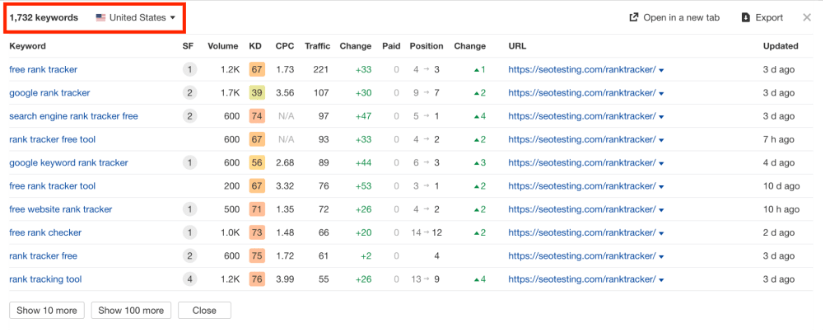
Our Free Rank Tracker page ranks for over 1,700 keywords in the USA alone, according to Ahrefs.
We also know that Google doesn’t operate on a “one query = one SERP” basis. It’s often the case that many different queries will bring up the same SERP, as there are many queries related to one another. These are known as ‘keyword clusters‘.
One of the best ways to get your content ranking for multiple queries is to include related keywords and sections within your content.
One of the easiest ways to do this? That’s right, utilizing People Also Search For keywords within your content.
Finding People Also Search For keywords and adding sections to your content is a great way to increase your content’s ranking for multiple keywords.
When you write more content for these related queries, Google and its ranking algorithm pick this up and will start showing your website for more of these search queries.
Read our guide about the best keyword clustering tools to help you build clusters more efficiently.
On-Page SEO Improvements
One thing will automatically happen as you pay more attention to People Also Search For keywords within your SEO campaigns… Your on-page SEO will generally improve as you do more and more work to rank your content for different People Also Search For keywords related to your target queries.
How does this happen? It’s a relatively simple process.
As you write more and more content pieces to rank for these keywords, you will have a larger library of content all related to the same topic. Take our content cluster on Google Search Console, for instance.
We started simple, with a Google Search Console guide. As we worked on more topics, the number of individual guides increased. We now have guides on 47 topics related to Google Search Console.
These articles link together naturally, meaning our website has a section where the on-page SEO is well done. We have related keywords linked within different articles, FAQ sections within guides that then link out to more comprehensive guides on the questions that have been answered and a hub page that links to every single one of our GSC guides.
What is the result of that? Lots of organic traffic…
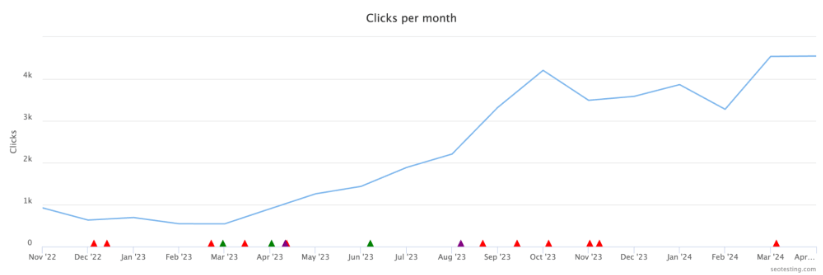
The above shows our Google Search Console content group, simply listing the 47 articles we have on different GSC-based topics. All of this leads to over 4,000 organic clicks per month!

How to Rank for People Also Search For Keywords
To round off this blog post, we’ll discuss the steps to start ranking content for keywords in the People Also Search For boxes within the Google SERPs.
Write Content for a ‘Seed’ Keyword
You should identify a primary keyword relevant to your business and website. It should be a term that is searched frequently by your target audience, and in almost all cases it will have been discovered through keyword research or discussions with your customers.
If you still need to research your keywords, you can check out our keyword research guide.
Once a seed keyword has been chosen, craft high-quality, comprehensive content around it. Ensure the content is informative, engaging, and valuable to your readers. Be sure to follow the “SEO basics” and optimize it by including your seed keyword in places where it makes sense throughout the copy.
Explore People Also Search For Keywords from your Seed Keyword
After your content (targeting your chosen seed keyword) has been published, the next step is to explore the People Also Search For keywords related to your seed keyword.
You can do this manually, or you can use a browser extension like Keywords Everywhere, as we showed you previously.
The end goal of this step is to have a list of related and long tail keywords related to your content targeting the seed keyword. It will look similar to a spreadsheet you’d create when doing keyword research for a particular topic.
If you want to get a little more granular with this data, you can use a tool like Ahrefs or Semrush to extract search volume data for your additional keywords. This will help you later on as you will be able to determine which additional content pieces need to be published sooner than others.
Run Keywords Through Keyword Insights
This step isn’t vital, but we would highly recommend it to save your content team time when we come to the final step of creating additional content.
Once you have the list of People Also Search For keywords you want to target, put them in a spreadsheet, and save them as a .csv file. You can then use Keyword Insights, import the .csv file into the tool, and allow it to cluster these keywords for you.
Keyword Insights runs through all of the SERPs for all the keywords in your list and groups the keywords into clusters. This way, you will know exactly what content needs to be written to target keywords.
Let’s take a look at this example:
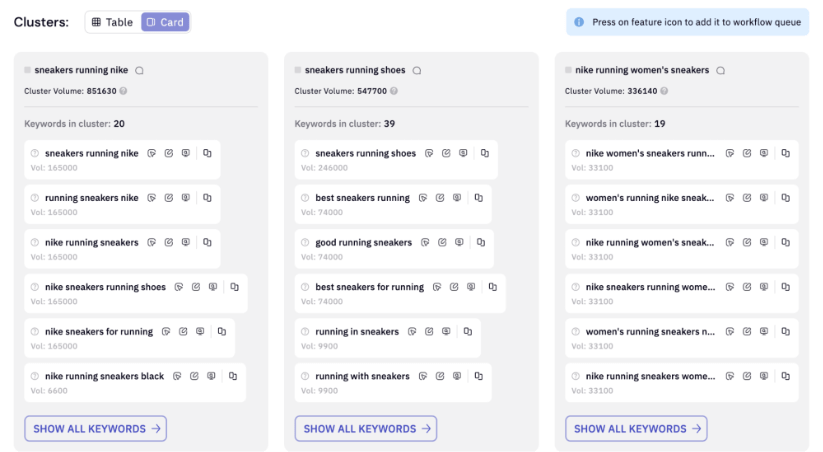
We imported a list of 246 keywords that we found additional to our seed keyword of ‘running shoes’ and imported the list into Keyword Insights. The tool then clustered all these keywords and established that we do not need to write 246 individual pieces of content as many keywords are grouped and produce the same SERP when a user searches them. This would save our content team a lot of time when creating the content in the long run. Not to mention the budget saved, too.
Write Additional Content
Your final step is writing additional content for your keywords and keyword clusters.
Remember to follow common best practices when writing your content. Make it unique, informative, and engaging for the user to read, and you can’t go wrong.
It’s now a process of creating pieces, ordered by the impact they will have over time, to increase organic traffic to your site.
Wrapping Up
Leveraging People Also Search For keywords is a game-changer for enhancing your SEO strategy. These keywords offer invaluable insights into user intent, revealing what additional information searchers seek after their initial query. Understanding and incorporating People Also Search For keywords allows you to create more targeted, comprehensive content that aligns closely with user needs, boosting engagement and conversion rates.
To fully capitalize on People Also Search For keywords, follow these steps: identify and write content for a seed keyword, explore related People Also Search For keywords, and use tools like Keywords Everywhere and Keyword Insights to streamline the process. This strategic approach will improve your content’s relevance and help you rank for multiple related keywords, thereby increasing your organic traffic.
Integrating People Also Search For keywords into your content planning and on-page SEO practices creates a robust content ecosystem that caters to a wide array of search queries. This enhances your site’s authority and visibility, leading to sustained growth in organic traffic. Remember, the key to success lies in understanding your audience’s intent and refining your content to meet their evolving needs.
With SEOTesting, you can track content experiments and see the impact of targeting People Also Search For keywords. Our comprehensive SEO testing features provide the insights you need to refine your strategy and boost organic traffic. Try SEOTesting for free with our 14-day trial-no credit card required.


